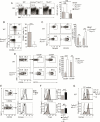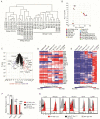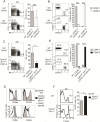Transforming Growth Factor-β Signaling Guides the Differentiation of Innate Lymphoid Cells in Salivary Glands
- PMID: 27156386
- PMCID: PMC5114145
- DOI: 10.1016/j.immuni.2016.03.007
Transforming Growth Factor-β Signaling Guides the Differentiation of Innate Lymphoid Cells in Salivary Glands
Abstract
The signals guiding differentiation of innate lymphoid cells (ILCs) within tissues are not well understood. Salivary gland (SG) ILCs as well as liver and intestinal intraepithelial ILC1 have markers that denote tissue residency and transforming growth factor-β (TGF-β) imprinting. We deleted Tgfbr2 in cells expressing the ILC and NK marker NKp46 and found that SG ILCs were reduced in number. They lost distinct tissue markers, such as CD49a, and the effector molecules TRAIL and CD73. Expression of the transcription factor Eomes, which promotes NK cell differentiation, was elevated. Conversely, Eomes deletion in NKp46(+) cells enhanced TGF-β-imprinting of SG ILCs. Thus, TGF-β induces SG ILC differentiation by suppressing Eomes. TGF-β acted through a JNK-dependent, Smad4-independent pathway. Transcriptome analysis demonstrated that SG ILCs had characteristic of both NK cells and ILC1. Finally, TGF-β imprinting of SG ILCs was synchronized with SG development, highlighting the impact of tissue microenvironment on ILC development.
Keywords: TGF-β; development; innate lymphoid cells; salivary gland; signaling; transcription factors.
Copyright © 2016 Elsevier Inc. All rights reserved.
Figures







References
-
- Atarashi K, Tanoue T, Oshima K, Suda W, Nagano Y, Nishikawa H, Fukuda S, Saito T, Narushima S, Hase K, et al. Treg induction by a rationally selected mixture of Clostridia strains from the human microbiota. Nature. 2013;500:232–236. - PubMed
-
- Cortez VS, Fuchs A, Cella M, Gilfillan S, Colonna M. Cutting edge: Salivary gland NK cells develop independently of Nfil3 in steady-state. J. Immunol. 2014;192:4487–4491. - PubMed
-
- Curotto de Lafaille MA, Lafaille JJ. CD4(+) regulatory T cells in autoimmunity and allergy. Curr. Opin. Immunol. 2002;14:771–778. - PubMed
MeSH terms
Substances
Grants and funding
LinkOut - more resources
Full Text Sources
Other Literature Sources
Molecular Biology Databases
Research Materials
Miscellaneous

